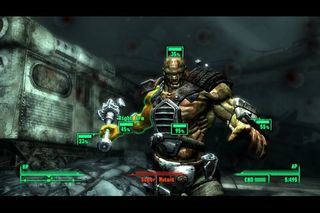We've seen Fallout 3
First details on Vault 101 will please fans and lure strangers to the post-apocalyptic wasteland
It's a clever move that kills two birds with one stone. In terms of design, the game's fresh approach to its tutorial introduces fans of the franchise to an intimate look at life in the Vault. But at the same time, by starting with your birth and chronicling your journey past childhood through adolescence, the tutorial serves the dual purpose of introducing players unfamiliar with the series to the world of Fallout through a child's eyes.
Change is often good, but messing with what fans love can be a dangerous business. Purists may scream bloody murder when they find out that the familiar isometric third-person view - and point-and-click control scheme - is gone. But the change from the original third-person view to "Oblivion with guns" is a welcome one. The way combat plays out - actually more of a mix of turn-based RPG combat (like how it was with the original Fallout games) with the freedom of camera movement that FPS' allow - has us convinced. Before fans call foul, take our word for it. Looks can be deceiving.

Above: The percentages listed above each of the points you can target on this enemy represent your chances of hitting it
While you can move and shoot as you would in a traditional shooter, the actual combat is a hybrid between turn-based and real-time action. Flying under the codename V.A.T.S., Fallout 3's Vault-Tec Assisted Targeting System slows time down to a standstill and brings up a set of targetable points on your enemy.
Using V.A.T.S. requires action points, which slowly regenerate over time. And although you could continue to blast away at baddies ala Quake or Unreal once your action points are spent, it won't be as effective as a "Vault-Tec" assisted shot. It seems like a novel way to introduce the stat-based, die roll mechanics of role-playing combat to the hands-on feel of a shooter.
Sign up to the 12DOVE Newsletter
Weekly digests, tales from the communities you love, and more

30 years later, Fallout creator Tim Cain is searching for a legendary D&D player who cheesed an entire competitive dungeon with a lightning-fast Monk build

Fallout creator Tim Cain says devs don't know what gamers want because "you don't know either" and that's why he used to just make games he and his team liked
Most Popular
